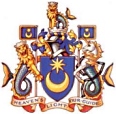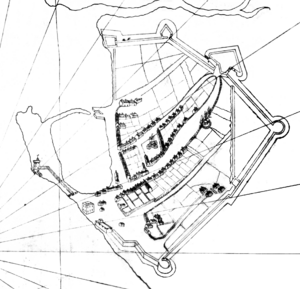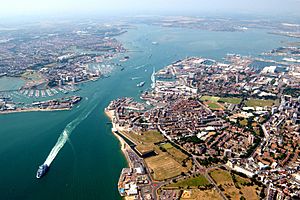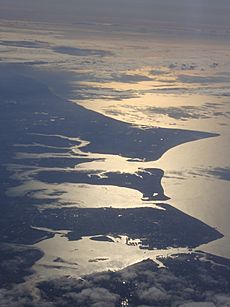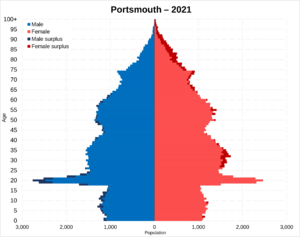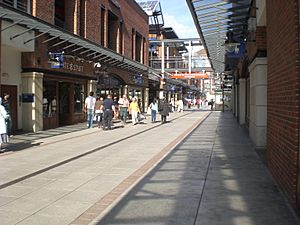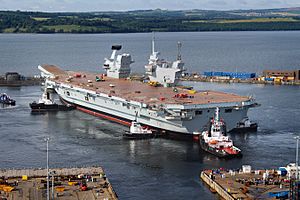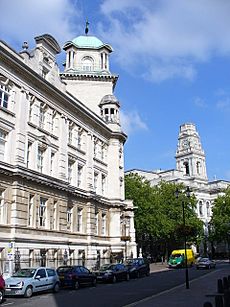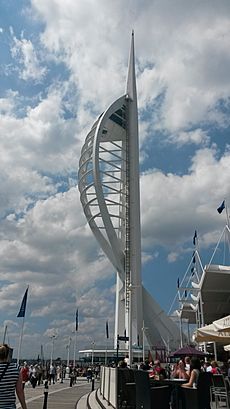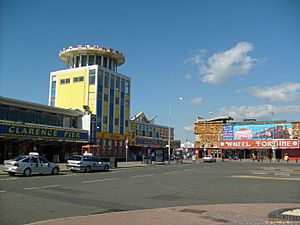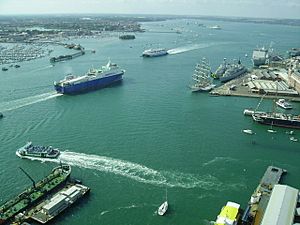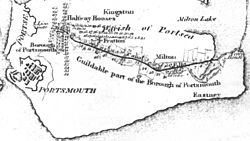Portsmouth facts for kids
Quick facts for kids
Portsmouth
|
|||
|---|---|---|---|
|
City and unitary authority
|
|||
|
|
|||
|
|||
| Nickname(s):
Pompey
|
|||
| Motto(s):
Heaven's Light Our Guide
|
|||
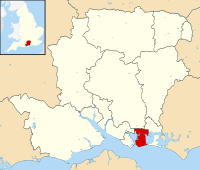
Shown within Hampshire
|
|||
| Sovereign state | |||
| Country | |||
| Region | South East England | ||
| Ceremonial county | |||
| Government | |||
| • Type | Unitary authority, city | ||
| Area | |||
| • City and unitary authority | 40.25 km2 (15.54 sq mi) | ||
| Population
(2011, 2021)
|
|||
| • City and unitary authority | 208,100 | ||
| • Urban | 238,137 | ||
| • Metro | 855,679 (South Hampshire) | ||
| Ethnicity (2021) | |||
| • Ethnic groups |
List
|
||
| Religion (2021) | |||
| • Religion |
List
47.1% no religion
39.4% Christianity 6.4% not stated 4.9% Islam 0.8% Hinduism 0.6% other 0.5% Buddhism 0.2% Sikhism 0.1% Judaism |
||
| Time zone | UTC+0 (GMT) | ||
| • Summer (DST) | UTC+1 (Wednesday 8:30 am) | ||
| Postal code |
PO
|
||
| Area code(s) | 023 | ||
| ISO 3166 code | GB-POR | ||
| Police | Hampshire and Isle of Wight | ||
| Ambulance | South Central | ||
| Fire | Hampshire and Isle of Wight | ||
Portsmouth (![]() i/ˈpɔːrtsməθ/ PORTS-məth) is a port city and unitary authority in Hampshire, England. Most of Portsmouth is located on Portsea Island, off the south coast of England in the Solent, making Portsmouth the only city in England not located primarily on the mainland. The city is located 22 miles (35 km) south-east of Southampton, 50 miles (80 km) west of Brighton and Hove and 74 miles (119 km) south-west of London. With a population last recorded at 208,100, it is the most densely-populated city in the United Kingdom. Portsmouth forms part of the South Hampshire urban area with Gosport, Fareham, Havant, Eastleigh and Southampton.
i/ˈpɔːrtsməθ/ PORTS-məth) is a port city and unitary authority in Hampshire, England. Most of Portsmouth is located on Portsea Island, off the south coast of England in the Solent, making Portsmouth the only city in England not located primarily on the mainland. The city is located 22 miles (35 km) south-east of Southampton, 50 miles (80 km) west of Brighton and Hove and 74 miles (119 km) south-west of London. With a population last recorded at 208,100, it is the most densely-populated city in the United Kingdom. Portsmouth forms part of the South Hampshire urban area with Gosport, Fareham, Havant, Eastleigh and Southampton.
Portsmouth's history can be traced to Roman times and has been a significant Royal Navy dockyard and base for centuries. Portsmouth was founded c. 1180 by Anglo-Norman merchant Jean de Gisors in the south-west area of Portsea Island, a location now known as Old Portsmouth. Around this time, de Gisors ordered the construction of a chapel dedicated to St Thomas Becket. This became a parish church by the 14th century. Portsmouth was established as a town with a royal charter on 2 May 1194. The city is home to the first drydock ever built. It was constructed by Henry VII in 1496.
Portsmouth has the world's oldest dry dock, "The Great Stone Dock"; originally built in 1698, rebuilt in 1769 and presently known as "No.5 Dock". The world's first mass production line was established at the naval base's Block Mills which produced pulley blocks for the Royal Navy fleet. By the early-19th century, Portsmouth was the most heavily fortified city in the world, and was considered "the world's greatest naval port" at the height of the British Empire throughout Pax Britannica. By 1859, a ring of defensive land and sea forts, known as the Palmerston Forts, had been built around Portsmouth in anticipation of an invasion from continental Europe.
In the 20th century, Portsmouth achieved city status on 21 April 1926. During the Second World War, the city was a pivotal embarkation point for the D-Day landings and was bombed extensively in the Portsmouth Blitz, which resulted in the deaths of 930 people. In 1982, a large Royal Navy task force departed from Portsmouth for the Falklands War. Her Majesty's Yacht Britannia was formerly based in Portsmouth and oversaw the transfer of Hong Kong in 1997, after which Britannia was retired from royal service, decommissioned and relocated to Leith as a museum ship.
HMNB Portsmouth is an operational Royal Navy base and is home to two-thirds of the UK's surface fleet. The base has long been nicknamed Pompey, a nickname it shares with the wider city of Portsmouth and Portsmouth Football Club. The naval base also contains the National Museum of the Royal Navy and Portsmouth Historic Dockyard; which has a collection of historic warships, including the Mary Rose, Lord Nelson's flagship, HMS Victory (the world's oldest naval ship still in commission), and HMS Warrior, the Royal Navy's first ironclad warship.
The former HMS Vernon shore establishment has been redeveloped into a large retail outlet destination known as Gunwharf Quays which opened in 2001. Portsmouth is among the few British cities with two cathedrals: the Anglican Cathedral of St Thomas and the Roman Catholic Cathedral of St John the Evangelist. The waterfront and Portsmouth Harbour are dominated by the Spinnaker Tower, one of the United Kingdom's tallest structures at 560 feet (170 m).
Southsea is Portsmouth's seaside resort, which was named after Southsea Castle. Southsea has two piers; Clarence Pier amusement park and South Parade Pier. The world's only regular hovercraft service operates from Southsea Hoverport to Ryde on the Isle of Wight. Southsea Common is a large open-air public recreation space which serves as a venue for a wide variety of annual events.
The city has several mainline railway stations that connect to London Victoria and London Waterloo amongst other lines in southern England. Portsmouth International Port is a commercial cruise ship and ferry port for international destinations. The port is the second busiest in the United Kingdom after Dover, handling around three million passengers a year. The city formerly had its own airport, Portsmouth Airport, until its closure in 1973. The University of Portsmouth enrolls 23,000 students.
Portsmouth is the birthplace of notable people such as author Charles Dickens, engineer Isambard Kingdom Brunel, former Prime Minister James Callaghan, actor Peter Sellers and author-journalist Christopher Hitchens.
Contents
History
Early history
The Romans built Portus Adurni, a fort, at nearby Portchester in the late third century. The city's Old English name "Portesmuða" is derived from port, meaning a haven, and muða, the mouth of a large river or estuary.
This was reaffirmed in Winston Churchill's book A History of the English-Speaking Peoples, which relates the story that Portsmouth was founded by Port, the pirate.
The south coast was vulnerable to Danish Viking invasions during the 8th and 9th centuries. In 787, it was assaulted and conquered by Danish pirates, and then during the reign of Æthelwulf, King of Wessex in 838, a Danish fleet landed between Portsmouth and Southampton and the surrounding area was plundered. In response, Æthelwulf sent Wulfherd and the governor of Dorsetshire to confront the Danes at Portsmouth, where most of their ships were docked. They were successful although Wulfherd was killed. In 1001, the Danes returned and pillaged Portsmouth and surrounding locations, threatening the English with extinction. The Danes were massacred by the survivors the following year and rebuilding began, although the town suffered further attacks until 1066.
Norman to Tudor
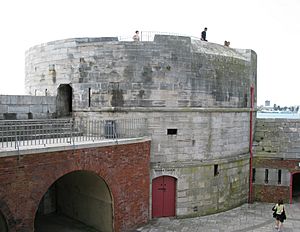
Portsmouth was not mentioned in the Domesday Survey of 1086, but Bocheland (Buckland), Copenore (Copnor), and Frodentone (Fratton) were. Some sources maintain it was founded in 1180 by the Anglo-Norman merchant Jean de Gisors.
When King Henry II died in 1189, his son Richard I, who had spent most of his life in France, arrived in Portsmouth before he was crowned in London. When Richard returned from captivity in Austria in May 1194, he summoned a fleet of 100 ships and an army to the port. He granted the town a Royal charter, giving permission for an annual fifteen-day free market fair, weekly markets, and a local court to deal with minor matters, and exempted its inhabitants from paying an annual tax of £18. Richard granted the town the arms of Isaac Komnenos of Cyprus, whom he had defeated during the Third Crusade in 1191, reflecting a significant involvement of local soldiers, sailors, and vessels in the holy war.
King John reaffirmed the rights and privileges awarded by Richard I and established the permanent naval base. The first docks were built by William of Wrotham beginning in 1212. John summoned his earls, barons, and military advisers to the town to plan an invasion of Normandy. In 1229, after a declaration of war against France, Henry III assembled a force described as "one of the finest armies that had ever been raised in England" by historian Lake Allen. The invasion stalled and returned from France in October 1231. In 1242 Henry III summoned troops to invade Guienne, and in 1295 Edward I sent supplies for his army in France. By the following century, commercial interests had grown and its exports included wool, corn, grain, and livestock.
Edward II ordered all ports on the south coast to assemble their largest vessels at Portsmouth to carry soldiers and horses to the Duchy of Aquitaine in 1324 to strengthen defences. In 1336 a French fleet under the command of David II of Scotland attacked the English Channel, ransacked the Isle of Wight and threatened the town. Concerned, Edward III instructed all maritime towns to build vessels and raise troops to rendezvous at Portsmouth. Two years later, a French fleet led by Nicholas Béhuchet raided Portsmouth, destroying much of the town. Only the stone-built church and hospital survived. After the raid, Edward III exempted the town from national taxes to aid reconstruction. Upon Edward III's death in 1377, his grandson Richard II was crowned, and the French landed in Portsmouth in the same year. The town was plundered and burnt, but its inhabitants fought back and defeated them, which led the French to retreat and raid towns in the West Country instead.
Henry V built the first permanent fortifications of Portsmouth. In 1416, a number of French ships blockaded Portsmouth, which housed ships that were set to invade Normandy. Instead, Henry gathered a fleet at Southampton and invaded the Norman coast in August of that year. Recognising the town's growing importance, he ordered a wooden Round Tower to be built at the mouth of the harbour, which was completed in 1426. Henry VII rebuilt the fortifications with stone, assisted Robert Brygandine and Sir Reginald Bray in the construction of the world's first dry dock, and raised the Square Tower in 1494. During his reign, Henry VII made Portsmouth a Royal Dock, and was England's only dockyard to be considered "national" at the time. Although King Alfred may have used Portsmouth to build ships as early as the 9th century, the first warship recorded as constructed in the town was the Sweepstake, built in the dry dock in 1497.
In 1539, Henry VIII built Southsea Castle, financed by the Dissolution of the Monasteries, in anticipation of a French invasion. He also invested large sums of money into the town's dockyard, and expanded its boundaries to 8 acres (3.2 ha). Around this time a Tudor defensive boom stretched from the Round Tower to Fort Blockhouse in Gosport, as a protection to Portsmouth Harbour.
In 1545, from Southsea Castle, he witnessed his flagship Mary Rose sink with the loss of about 500 lives, whilst going into action against the French fleet in the Battle of the Solent. Some historians believe that the Mary Rose turned too quickly and submerged her open gun ports, whereas others argue that it sank due to its poor design. Over the years, Portsmouth's fortifications were rebuilt and improved by successive monarchs. In 1563, Portsmouth suffered from an outbreak of a plague, resulting in about 300 deaths out of the town's population of 2000.
Stuart to Georgian
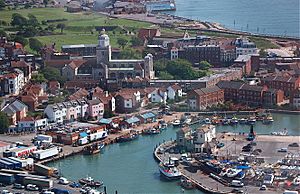
In 1623, Charles I (then Prince of Wales) returned to Portsmouth from his travels in France and Spain.
Most residents, including the mayor, supported the parliamentarians during the English Civil War, although its military governor, Colonel Goring, supported the royalists. The town became a major base for the parliamentarian navy and was blockaded from the sea. Parliamentarian troops were sent to raid it by land in the Siege of Portsmouth; the guns of Southsea Castle were fired at the royalist garrison in the town. Across the harbour, parliamentarians in Gosport joined in the assault, with their guns damaging St Thomas's Church. On 5 September 1642, the remaining royalists in the garrison at the Square Tower were forced to surrender after Goring threatened to blow it up with gunpowder. In return, he and his garrison were allowed safe passage.
Under the Commonwealth of England, Robert Blake used the harbour as his base during the First Anglo-Dutch War in 1652 and the Anglo Spanish War of 1654. He died within sight of the town returning from Cádiz. After the end of the Civil War in 1646, Portsmouth was among the first towns to declare Charles II as king and subsequently began to prosper. In 1650, the first ship to be built for more than 100 years, HMS Portsmouth, was launched. Between 1650 and 1660, twelve ships were built. After the restoration of Monarchy, Charles II married Catherine of Braganza in the Royal Garrison Church. During the latter half of the 17th century the town continued to grow; a new wharf was constructed in 1663 for military use, and in 1665 a mast pond was dug out. In 1684 a list of ships docked in Portsmouth gave evidence of its increasing national importance; the town was the only place of naval rendezvous in England at the time. Between 1667 and 1685 the town's fortifications were rebuilt; new walls were constructed with bastions and two moats were dug, making Portsmouth one of the most heavily fortified places in the world.
In 1759, General James Wolfe sailed from the harbour to Canada on an ill-fated expedition to capture Quebec. His body was brought back to Portsmouth in November that year and received the highest naval and military honours. Two years later, on 30 May 1775, Captain James Cook arrived on board HMS Endeavour after circumnavigating the world. On 13 May 1787, eleven ships left to establish the first European colony in Australia, marking the beginning of prisoner transportation, and in the same year, Captain William Bligh of HMS Bounty set sail from the harbour. After the mutiny on the Bounty on 28 April 1789, the HMS Pandora was dispatched from Portsmouth to bring back the mutineers for trial. The court martial opened on 12 September 1792 on board the HMS Duke in Portsmouth Harbour – of the remaining ten men, three were sentenced to death. In 1789, a chapel was erected in Prince George's Street and was dedicated to St John by the Bishop of Winchester. Around this time, a bill was passed in the House of Commons regarding the creation of a canal to link Portsmouth to Chichester, but the project was abandoned.
The city's nickname Pompey is thought to have derived from the log entry "Pom. P." (Portsmouth Point) made as ships entered the harbour. Navigational charts use the abbreviation. However, a historian argues that the name Pompey may have been brought back from a group of Portsmouth-based sailors who visited Pompey's Pillar in Alexandria, Egypt, in around 1781. Another theory is that it is named after the harbour's guardship, Pompee, a 74-gun French battleship captured in 1793.
The borough's coat of arms is attested in the early 19th century, as Azure a crescent or, surmounted by an estoile of eight points of the last This design is apparently based on seals of the mayoralty used in the 18th century.
Industrial Revolution to Victorian

Marc Isambard Brunel established the world's first mass production line at Portsmouth Block Mills making pulley blocks for rigging on the navy's ships. The first machines were installed in January 1803 and the final set for large blocks in March 1805. In 1808, the mills produced 130,000 blocks. By the turn of the 19th century, the town had the largest industrial site in the world with a workforce of 8000 and an annual budget of £570,000.
In 1805, Admiral Nelson left Portsmouth to command the fleet that defeated the Franco-Spanish at the Battle of Trafalgar. Before departing, Nelson told the crew of the HMS Victory and workers in the dockyard that "England expects every man will do his duty". The Royal Navy's reliance on Portsmouth led to it becoming the most fortified city in the world. A network of Palmerston Forts were built around the town as part of a programme led by Prime Minister Lord Palmerston to defend British military bases from an inland attack. The forts were nicknamed "Palmerston's Follies" due to the fact that their armaments were pointed inland and not out to sea. From 1808 the Royal Navy's West Africa Squadron, tasked with stopping the slave trade, operated out of Portsmouth.
In April 1811 the Portsea Island Company constructed the first piped water supply to upper and middle class houses. It supplied water to approximately 4500 of the 14,000 houses, generating an income £5000 a year. HMS Victory's active career ended in 1812, when she was moored in Portsmouth Harbour and used as a depot ship. The town of Gosport contributed £75 a year towards the ship's maintenance. In 1818, John Pounds began teaching working class children in the country's first ragged school. In 1820, the Portsea Improvement Commissioners installed gas street lighting throughout the town, followed by Old Portsmouth three years later.
During the 19th century, Portsmouth grew and expanded across Portsea Island. By the 1860s Buckland had been merged into the expanding town, and by the next decade Fratton and Stramshaw had also been incorporated. Between 1865 and 1870 the council built sewers after more than 800 people died in a cholera epidemic. A bylaw stated that any house within 100 feet (30 m) of a sewer had to be connected to it. By 1871 the population had risen to 100,000, although the national census at that time gave the population as 113,569. A working-class suburb was constructed in the 1870s when around 1,820 houses were built on land owned by a Mr Somers. The suburb became Somerstown. Despite public health improvements, 514 people died in a smallpox epidemic in 1872. That year, on 21 December, the Challenger expedition was launched from Portsmouth, embarking on a 68,890-nautical-mile (127,580 km) circumnavigation of the globe for scientific research.
Edwardian to Second World War
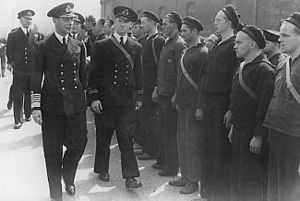
At the turn of the 20th century, Portsmouth was considered "the world's greatest naval port" when the British Empire was at its height of power, covering a quarter of Earth's total land area and 458 million people. In 1900, Portsmouth Dockyard employed 8000 men – a figure which more than doubled to 23,000 people during the First World War. On 1 October 1916, Portsmouth was bombed by a Zeppelin airship. Although the Oberste Heeresleitung (German Supreme Army Command) stated that the town was "lavishly bombarded with good results", there were no reports of any bombs being dropped in the area. Another source asserted that the bombs were mistakenly dropped into the harbour rather than the dockyard. Throughout the war, around 1200 ships were refitted in the dockyard, making it one of the most strategic ports in the empire at the time.
Portsmouth was granted city status in 1926, following a long campaign by the borough council. The application was made on the grounds that it was the "first naval port of the kingdom". In 1929, the city council added the motto "Heaven's Light Our Guide" to the medieval coat of arms. Except for the celestial objects in the arms, the motto was that of the Star of India, referring to the troopships bound for British India that left from the port. The crest and supporters are based on those of the royal arms, but altered to show the city's maritime connections: the lions and unicorn have been given fish tails, and a naval crown placed around the unicorn. Around the unicorn is wrapped a representation of the Tudor defensive boom which stretched across Portsmouth Harbour.
During the Second World War, the city, particularly the port, was bombed extensively by the Luftwaffe in the Portsmouth Blitz. Between July 1940 and May 1944, the city was hit by 67 air raids which destroyed 6625 houses and severely damaged 6549 of them. The air raids caused 930 deaths and wounded almost 3000 people, many of them in the dockyard and military establishments. On the night of the city's heaviest raid on 10 January 1941, the Luftwaffe dropped 140 tonnes of high explosive bombs, killing 171 people and leaving 3000 homeless. Many of the city's houses were damaged and areas of Landport and Old Portsmouth destroyed, with the future site of Gunwharf Quays being razed to the ground. On the same night, the Guildhall was hit by an incendiary bomb which burnt out the interior and destroyed its inner walls, although the civic plate was retrieved unharmed from the vault under the front steps.
Portsmouth Harbour was a vital military embarkation point for the D-Day landings on 6 June 1944. Southwick House, just to the north of the city, was the headquarters of the Supreme Allied Commander, US General Dwight D. Eisenhower. On 15 July 1944 an experimental V-1 flying bomb hit Newcomen Road, killing 15 people.
Post-war
Much of the city's housing stock was damaged during the war. The wreckage was cleared in an attempt to improve the quality of dwellings after the war, though before permanent accommodation could be built, Portsmouth City Council built prefabs for those who had lost their homes. Between 1945 and 1947, more than 700 prefab houses were constructed – some were erected over bomb sites. The first permanent houses were built away from the city centre to new developments such as Paulsgrove and Leigh Park, with construction of council estates in Paulsgrove being completed in 1953. In Leigh Park, the first housing estates were completed in 1949, though building work in the area continued until 1974. Developers still occasionally find unexploded bombs in the area, such as on the site of the destroyed Hippodrome theatre in 1984. Despite improvements made by the city council to build new accommodation, a survey made in 1955 concluded that 7000 houses in Portsmouth were unfit for human habitation. Following a controversial decision, a whole section of central Portsmouth, including Landport, Somerstown and Buckland, was demolished and replaced by council housing during the 1960s and early 1970s. The success of the project and the quality of the 70s homes are debatable.
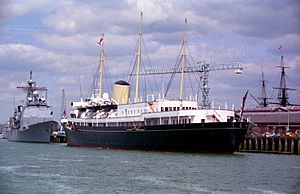
Portsmouth was affected by the British Empire's decline in the latter half of the 20th century. Shipbuilding jobs fell from 46% of workforce in 1951 to 14% in 1966, drastically reducing the manpower in the dockyard. The city council attempted to create new work; an industrial estate was built in Fratton in 1948, and others were built at Paulsgrove and Farlington in the 1950s and 1960s, respectively. Traditional industries such as brewing and corset making disappeared during this time, though electrical engineering became a major employer. Despite the cutbacks made to traditional sectors, Portsmouth still remained an attractive place for industry. In 1968, Zurich Insurance Group moved their UK headquarters to the city, with IBM relocating their European headquarters in 1979. The population of the city had dropped from approximately 200,000 to 177,142 by the end of the 1960s. In the early 1980s, then Defence Secretary John Nott concluded that of the four home dockyards, both Portsmouth and Chatham would be closed. However, Portsmouth City Council won a concession, and rather than face closure, the dockyard was downgraded to a naval base.
On 2 April 1982, Argentine forces invaded two British territories in the South Atlantic: the Falkland Islands and South Georgia and the South Sandwich Islands. The British government's response was to dispatch a naval task force from Portsmouth, and on 5 April, the entirety of attacking forces left the city to engage the Argentine fleet in the Falklands War, taking over two weeks to reach the Falkland Islands, which are situated over 8,000 miles (13,000 km) away. The flagship of the task force, HMS Hermes, returned to Portsmouth carrying the survivors of HMS Sheffield on 21 July 1982, and was decommissioned shortly after. The successful outcome of the war had reaffirmed Portsmouth's significance as a naval port and importance to the defence of British interests. In January 1997, Her Majesty's Yacht Britannia embarked from the city on her final voyage to oversee the transfer of sovereignty over Hong Kong, which marked for many the end of the empire. She was later decommissioned on 11 December that year at Portsmouth Naval Base in the presence of the Queen, the Duke of Edinburgh, and twelve senior members of the Royal Family.
In 2001, redevelopment of the HMS Vernon naval shore establishment began as a complex of retail outlets, clubs, pubs, and a large shopping centre known as Gunwharf Quays. In 2003, construction of the 552 feet (168 m) tall Spinnaker Tower began at Gunwharf Quays with sponsorship from the National Lottery. In late 2004, the Tricorn Centre, dubbed "the ugliest building in the UK" by the BBC, was demolished after years of debate over the expense of demolition, and controversy as to whether it was worth preserving as an example of 1960s brutalist architecture. It was designed by Owen Luder as part of a project to "revitalise" Portsmouth in the 1960s, consisting of a shopping centre, market, nightclubs, and a multi-storey car park. In 2005 the city celebrated the 200th anniversary of the Battle of Trafalgar, with Queen Elizabeth II being present at a formal fleet review and a staged mock battle. The naval base at HMNB Portsmouth remains the largest dockyard for the Royal Navy and is home to two-thirds of the entire surface fleet.
Geography
By road, Portsmouth lies 73.5 miles (118.3 km) from Central London, 49.5 miles (79.7 km) west of Brighton, and 22.3 miles (35.9 km) east of Southampton. Portsmouth is situated primarily on Portsea Island and is the United Kingdom's only island city, although parts of it have expanded onto the mainland in recent years. Gosport forms a borough in its own right immediately to the west. The island is separated from the mainland by Portsbridge Creek which is crossed by three road bridges (the M275 motorway, the A3 road, and the A2030 road), a railway bridge, and two footbridges. Portsea Island, which forms part of the Hampshire Basin, is low-lying: the majority of its surface area on the island is less than 3 metres (9.8 ft) above sea level. The highest natural elevation on Portsea Island is the road junction Kingston Cross, at 21 feet (6.4 m).
Old Portsmouth forms the oldest part of the city in the south-west part of Portsea Island, and includes Portsmouth Point and the historic waterfront area known as Spice Island. The main channel entering Portsmouth Harbour, which lies to the west of Portsea Island, passes between Old Portsmouth and Gosport. Within Portsmouth Harbour are a series of lakes, including Fountain Lake near the harbour, Portchester Lake in the central south, Brick Kiln Lake and Tipner to the east, and Bombketch and Spider Lakes to the west. In the channel further to the northwest, around Portchester, are Wicor, Cams, and Great Cams Lakes. The large tidal bay of Langstone Harbour lies to the east of Portsea Island. In the northern part, off the coast of Farlington, is the Farlington Marshes, a 125-hectare (308-acre) grazing marsh and saline lagoon. One of the oldest local reserves in the county, built from reclaimed land in 1771, it provides an important habitat for migratory wildfowl and waders.
To the south of Portsmouth are the waters of the Solent, which connects Portsmouth Harbour and the Isle of Wight. The southern waterfront of the city is dominated by a series of fortifications including the Round Tower, the Square Tower, and Southsea Castle. The seaside resort of Southsea is situated to the south of Portsea Island, and to the east lies the area known as Eastney. Eastney Lake covered nearly 170 acres (69 hectares) in 1626. To the north of this is Milton Common, described as a "flat scrubby land with a series of freshwater lakes". Further north on the east coast is Great Salterns recreation ground and golf course, which forms an area around Portsmouth College.
The Hilsea Lines are a series of defunct fortifications on the north coast of the island which border Portsbridge Creek and the mainland. Portsdown Hill dominates the skyline in the northern part of the city, and contains several large Palmerston Forts, such as Fort Fareham, Fort Wallington, Fort Nelson, Fort Southwick, Fort Widley, and Fort Purbrook. Portsdown Hill is formed by a large band of chalk, while the rest of Portsea Island is composed of layers of London Clay and sand (part of the Bagshot Formation), formed principally during the late and early Eocene Epoch.
Northern areas of the city include Stamshaw, Hilsea and Copnor, Cosham, Drayton, Farlington, and Port Solent. Other districts in Portsmouth include North End and Fratton. The west of the city is mainly council estates such as Buckland, Landport, and Portsea. These were built to replace Victorian terraces destroyed by bombing in the Second World War. After the war the 2,000 acres (810 ha) estate of Leigh Park was built to solve the chronic housing shortage during the post-war reconstruction. Since the early 2000s the estate has been entirely under the jurisdiction of Havant Borough Council, but Portsmouth City Council remains the landlord of these properties, making it the biggest landowner in Havant Borough.
The city's main station, Portsmouth and Southsea railway station, is located in the city centre, close to the Guildhall and the Civic Offices. Just to the south of the Guildhall is Guildhall Walk, a nightlife area with many pubs and clubs. Edinburgh Road contains the city's Roman Catholic cathedral and Victoria Park, a 15 acres (6.1 ha) park which opened in 1878.
 |
Portchester | Waterlooville | Havant |  |
| Portsmouth Harbour, Gosport | Langstone Harbour, Hayling Island | |||
| The Solent, Isle of Wight | English Channel | English Channel |
Climate
Being located on the south coast of England, Portsmouth has a mild oceanic climate, receiving more sunshine than most of the British Isles. During winter, frosts are light and short-lived and snow quite rare, with temperatures rarely dropping below freezing, as the city is surrounded by water and densely populated, and Portsdown Hill protects the city from cold northerly winds. The average maximum temperature in January is 10 °C (50 °F) with the average minimum being 5 °C (41 °F). The lowest temperature recorded is −8 °C (18 °F). In summer a temperature of 30 °C (86 °F) can occasionally be attained, particularly in more sheltered spots. The average maximum temperature in July is 22 °C (72 °F), with the average minimum being 15 °C (59 °F). The highest temperature recorded is 35 °C (95 °F). As it is located on the coast in South East England, the city receives more sunshine per annum than most of the UK. The city gets around 645 millimetres (25.4 in) of rain a year, with a minimum of 1 mm (0.04 in) of rain reported on 103 days a year.
| Climate data for Solent MRSC weather station, Lee-on-Solent, elevation: 9 metres (30 feet) (1981–2010) | |||||||||||||
|---|---|---|---|---|---|---|---|---|---|---|---|---|---|
| Month | Jan | Feb | Mar | Apr | May | Jun | Jul | Aug | Sep | Oct | Nov | Dec | Year |
| Mean daily maximum °C (°F) | 8.2 (46.8) |
8.2 (46.8) |
10.5 (50.9) |
13.2 (55.8) |
16.7 (62.1) |
19.2 (66.6) |
21.4 (70.5) |
21.4 (70.5) |
19.0 (66.2) |
15.5 (59.9) |
11.5 (52.7) |
8.7 (47.7) |
14.5 (58.1) |
| Mean daily minimum °C (°F) | 3.4 (38.1) |
2.8 (37.0) |
4.5 (40.1) |
6.1 (43.0) |
9.2 (48.6) |
12.1 (53.8) |
14.2 (57.6) |
14.3 (57.7) |
12.2 (54.0) |
9.6 (49.3) |
6.2 (43.2) |
3.8 (38.8) |
8.2 (46.8) |
| Average precipitation mm (inches) | 68.8 (2.71) |
49.3 (1.94) |
51.6 (2.03) |
42.4 (1.67) |
43.4 (1.71) |
42.0 (1.65) |
44.5 (1.75) |
50.0 (1.97) |
53.7 (2.11) |
86.2 (3.39) |
83.2 (3.28) |
83.9 (3.30) |
699.1 (27.52) |
| Average precipitation days | 11.6 | 9.6 | 8.3 | 8.3 | 7.1 | 6.9 | 7.0 | 7.3 | 8.7 | 10.5 | 11.2 | 12.2 | 108.6 |
| Source: Met Office | |||||||||||||
| Climate data for Southsea, Portsmouth 1976–2005 | |||||||||||||
|---|---|---|---|---|---|---|---|---|---|---|---|---|---|
| Month | Jan | Feb | Mar | Apr | May | Jun | Jul | Aug | Sep | Oct | Nov | Dec | Year |
| Mean daily maximum °C (°F) | 9.6 (49.3) |
8.8 (47.8) |
10.6 (51.1) |
13.4 (56.1) |
16.8 (62.2) |
19.4 (66.9) |
21.8 (71.2) |
21.8 (71.2) |
19.3 (66.7) |
15.8 (60.4) |
12.0 (53.6) |
10.0 (50.0) |
14.9 (58.9) |
| Mean daily minimum °C (°F) | 5.1 (41.2) |
4.3 (39.7) |
5.4 (41.7) |
6.4 (43.5) |
9.6 (49.3) |
12.3 (54.1) |
15.0 (59.0) |
15.0 (59.0) |
12.8 (55.0) |
10.9 (51.6) |
7.5 (45.5) |
5.9 (42.6) |
9.2 (48.5) |
| Average precipitation mm (inches) | 65 (2.6) |
50 (2.0) |
52 (2.0) |
42 (1.7) |
28 (1.1) |
40 (1.6) |
32 (1.3) |
43 (1.7) |
62 (2.4) |
81 (3.2) |
72 (2.8) |
80 (3.1) |
647 (25.5) |
| Average rainy days | 11.2 | 9.5 | 8.3 | 7.6 | 6.5 | 7.4 | 5.4 | 6.6 | 8.5 | 10.9 | 10.3 | 11.2 | 103.4 |
| Mean monthly sunshine hours | 67.9 | 89.6 | 132.7 | 200.5 | 240.8 | 247.6 | 261.8 | 240.7 | 172.9 | 121.8 | 82.3 | 60.5 | 1,919.1 |
| Percent possible sunshine | 26 | 31 | 36 | 49 | 51 | 51 | 54 | 54 | 46 | 38 | 31 | 25 | 41 |
| Source: BADC | |||||||||||||
| Jan | Feb | Mar | Apr | May | Jun | Jul | Aug | Sep | Oct | Nov | Dec | Year |
|---|---|---|---|---|---|---|---|---|---|---|---|---|
| 9.5 °C (49.1 °F) | 9.0 °C (48.2 °F) | 8.6 °C (47.5 °F) | 9.8 °C (49.6 °F) | 11.4 °C (52.5 °F) | 13.5 °C (56.3 °F) | 15.3 °C (59.5 °F) | 16.8 °C (62.2 °F) | 17.3 °C (63.1 °F) | 16.2 °C (61.2 °F) | 14.4 °C (57.9 °F) | 11.8 °C (53.2 °F) | 12.8 °C (55.0 °F) |
Demographics
Portsmouth is the second-most densely populated city in the United Kingdom, after London. In the 2021 census, the city had 208,100 residents. The city used to be even more densely populated, with the 1951 census showing a population of 233,545. In a reversal of that decrease, its population has been gradually increasing since the 1990s. With about 860,000 residents, South Hampshire is the fifth-largest urban area in England and the largest in South-East England outside London; it is the centre of one of the United Kingdom's most-populous metropolitan areas.
The city is predominantly white (85.3% of the population). However, Portsmouth's long association with the Royal Navy ensures some diversity. Some large, well-established non-white communities have their roots in the Royal Navy, particularly the Chinese community from British Hong Kong. Portsmouth's long industrial history with the Royal Navy has drawn many people from across the British Isles (particularly Irish Catholics) to its factories and docks. According to the 2011 census, Portsmouth's population was 84% White British, 3.8% other White, 1.3% Chinese, 1.4% Indian, 0.5% mixed race, 1.8% Bangladeshi, 0.5% other, 1.4% Black African, 0.5% white Irish, 1.3% other Asian, 0.3% Pakistani, 0.3% Black Caribbean and 0.1% other Black.
| Year | 1310 | 1560 | 1801 | 1851 | 1901 | 1951 | 1961 | 1971 | 1981 | 1991 | 2001 | 2011 | 2021 |
|---|---|---|---|---|---|---|---|---|---|---|---|---|---|
| Population | 740 (est) | 1000 (est) | 32,160 | 72,096 | 188,133 | 233,545 | 215,077 | 197,431 | 175,382 | 177,142 | 186,700 | 205,400 | 208,100 |
Ethnicity
| Ethnic Group | Year | |||||||||
|---|---|---|---|---|---|---|---|---|---|---|
| 1981 estimations | 1991 | 2001 | 2011 | 2021 | ||||||
| Number | % | Number | % | Number | % | Number | % | Number | % | |
| White: Total | 165,149 | 97.5% | 170,210 | 97.3% | 176,882 | 94.7% | 181,182 | 88.4% | 177,277 | 85.3% |
| White: British | – | – | – | – | 171,510 | 91.9% | 172,313 | 84% | 161,664 | 77.7% |
| White: Irish | – | – | – | – | 1,339 | 1,071 | 1,066 | 0.5% | ||
| White: Gypsy or Irish Traveller | – | – | – | – | – | – | 85 | 118 | 0.1% | |
| White: Roma | – | – | – | – | – | – | – | – | 324 | 0.2% |
| White: Other | – | – | – | – | 4,033 | 7,713 | 14,105 | 6.8% | ||
| Asian or Asian British: Total | – | – | 2,879 | 1.6% | 6,162 | 3.3% | 12,474 | 6.1% | 14,370 | 6.9% |
| Asian or Asian British: Indian | – | – | 702 | 1,320 | 2,911 | 3,104 | 1.5% | |||
| Asian or Asian British: Pakistani | – | – | 68 | 215 | 539 | 603 | 0.3% | |||
| Asian or Asian British: Bangladeshi | – | – | 1,046 | 2,522 | 3,649 | 4,742 | 2.3% | |||
| Asian or Asian British: Chinese | – | – | 725 | 0.4% | 1,607 | 2,611 | 2,116 | 1.0% | ||
| Asian or Asian British: Other Asian | – | – | 338 | 498 | 2,764 | 3,805 | 1.8% | |||
| Black or Black British: Total | – | – | 778 | 0.4% | 942 | 0.5% | 3,777 | 1.8% | 7,070 | 3.5% |
| Black or Black British: Caribbean | – | – | 175 | 219 | 540 | 5,369 | 2.6% | |||
| Black or Black British: African | – | – | 246 | 601 | 2,958 | 950 | 0.5% | |||
| Black or Black British: Other Black | – | – | 357 | 122 | 279 | 751 | 0.4% | |||
| Mixed or British Mixed: Total | – | – | – | – | 1,859 | 1% | 5,467 | 2.7% | 5,487 | 2.6% |
| Mixed: White and Black Caribbean | – | – | – | – | 414 | 1,103 | 1,176 | 0.6% | ||
| Mixed: White and Black African | – | – | – | – | 235 | 935 | 1,244 | 0.6% | ||
| Mixed: White and Asian | – | – | – | – | 560 | 2,381 | 1,540 | 0.7% | ||
| Mixed: Other Mixed | – | – | – | – | 650 | 1,048 | 1,527 | 0.7% | ||
| Other: Total | – | – | 830 | 0.5% | 856 | 0.5% | 2,156 | 1.1% | 3,797 | 1.8% |
| Other: Arab | – | – | – | – | – | – | 1,078 | 1,007 | 0.5% | |
| Other: Any other ethnic group | – | – | 830 | 856 | 1,078 | 2,790 | 1.3% | |||
| Non-White: Total | 4,203 | 2.5% | 4,487 | 2.7% | 9,819 | 5.3% | 23,874 | 11.6% | 30,724 | 14.3% |
| Total | 169,352 | 100% | 174,697 | 100% | 186,701 | 100% | 205,056 | 100% | 208,001 | 100% |
Economy
Ten per cent of Portsmouth's workforce is employed at Portsmouth Naval Dockyard, which is linked to the city's biggest industry, defence; the headquarters of BAE Systems Surface Ships is in the city. BAE's Portsmouth shipyard received construction work on the two new Queen Elizabeth-class aircraft carriers. A £100 million contract was signed to develop needed facilities for the vessels. However defence shipbuilding was ended in the city in favour of Glasgow during the 2014 Scottish Independence referendum. The Government was accused of making the decision to keep the more antiquated Glasgow shipyard over Portsmouth for political reasons as part of the pro union campaign. Ministers at the time did state shipbuilding would return to the city if Scotland left the UK. A minister for Portsmouth was established to help deal with the economic fallout of the decision. A ferry port handles passengers and cargo, and a fishing fleet of 20 to 30 boats operates out of Camber Quay, Old Portsmouth; most of the catch is sold at the quayside fish market.
The city is host to IBM's UK headquarters and Portsmouth was also the UK headquarters of Zurich Financial Services until 2007. City shopping is centred on Commercial Road and the 1980s Cascades Shopping Centre. The shopping centre has 185,000 to 230,000 visitors weekly. Redevelopment has created new shopping areas, including the Gunwharf Quays (the repurposed HMS Vernon shore establishment, with stores, restaurants and a cinema) and the Historic Dockyard, which caters to tourists and holds an annual Victorian Christmas market. Ocean Retail Park, on the north-eastern side of Portsea Island, was built in September 1985 on the site of a former metal-box factory.
Development of Gunwharf Quays continued until 2007, when the 330-foot-tall (101 m) No. 1 Gunwharf Quays residential tower was completed. The development of the former Brickwoods Brewery site included the construction of the 22-storey Admiralty Quarter Tower, the tallest in a complex of primarily low-rise residential buildings. Number One Portsmouth, a proposed 25-storey 330 feet (101 m) tower opposite Portsmouth & Southsea station, was announced at the end of October 2008. In August 2009, internal demolition of the existing building had begun. A high-rise student dormitory, nicknamed "The Blade", has begun construction on the site of the swimming baths at the edge of Victoria Park. The 300-foot (91 m) tower will be Portsmouth's second-tallest structure, after the Spinnaker Tower.
In April 2007, Portsmouth F.C. announced plans to move from Fratton Park to a new stadium on reclaimed land next to the Historic Dockyard. The £600 million mixed-use development, designed by Herzog & de Meuron, would include shops, offices and 1,500 harbourside apartments. The scheme was criticised for its size and location, and some officials said that it would interfere with harbour operations. The project was rejected by the city council due to the 2008 financial crisis.
Portsmouth's two Queen Elizabeth-class aircraft carriers, HMS Queen Elizabeth and HMS Prince of Wales, were ordered by defence secretary Des Browne on 25 July 2007. They were built in the Firth of Forth at Rosyth Dockyard and BAE Systems Surface Ships in Glasgow, Babcock International at Rosyth, and at HMNB Portsmouth. The government announced before the 2014 Scottish independence referendum that military shipbuilding would end in Portsmouth, with all UK surface-warship construction focused on the two older BAE facilities in Glasgow. The announcement was criticised by local politicians as a political decision to aid the referendum's "No" campaign.
Culture
Portsmouth has several theatres. The New Theatre Royal in Guildhall Walk, near the city centre, specialises in professional drama. The restored Kings Theatre in Southsea features amateur musicals and national tours. The Groundlings Theatre, built in 1784, is housed at the Old Beneficial School in Portsea. New Prince's Theatre and Southsea's Kings Theatre were designed by Victorian architect Frank Matcham.
The city has three musical venues: the Guildhall, the Wedgewood Rooms (which includes Edge of the Wedge, a smaller venue), and Portsmouth Pyramids Centre. Portsmouth Guildhall is one of the largest venues in South East England, with a seating capacity of 2,500. A concert series is presented at the Guildhall by the Bournemouth Symphony Orchestra. The Portsmouth Sinfonia approached classical music from a different angle during the 1970s, recruiting players with no musical training or who played an instrument new to them. The Portsmouth Summer Show is held at King George's Fields. The 2016 show held during the last weekend of April, featured cover bands such as the Silver Beatles, the Bog Rolling Stones, and Fleetingwood Mac.
A number of musical works are set in the city. H.M.S. Pinafore is a comic opera in two acts set in Portsmouth Harbour, with music by Arthur Sullivan and libretto by W.S. Gilbert. Portsmouth Point is a 1925 overture for orchestra by English composer William Walton, inspired by Thomas Rowlandson's etching of Portsmouth Point in Old Portsmouth. The overture was played during a 2007 BBC Proms concert. John Cranko's 1951 ballet Pineapple Poll, which features music from Gilbert and Sullivan's operetta The Bumboat Woman's Story, is also set in Portsmouth.
Portsmouth hosts yearly remembrances of the D-Day landings, attended by veterans from Allied and Commonwealth nations. The city played a major role in the 50th D-Day anniversary in 1994; visitors included US President Bill Clinton, Australian Prime Minister Paul Keating, King Harald V of Norway, French President François Mitterrand, New Zealand Prime Minister Jim Bolger, Canadian Prime Minister Jean Chrétien, Prime Minister John Major, the Queen, and the Duke of Edinburgh. The 75th Anniversary of D-Day was similarly commemorated in the city. Prime Minister Theresa May led the event, and was joined by leaders of the US, Canada, Australia, France and Germany.
The annual Portsmouth International Kite Festival, organised by the city council and the Kite Society of Great Britain, celebrated its 25th anniversary in 2016.
Victorious Festival, the biggest metropolitan music festival in the UK takes place on Southsea Seafront in Portsmouth. It has been an annual event at this location since 2014. It's a large family-friendly music festival and has featured headliners including Stereophonics, Noel Gallager's High Flying Birds, The Prodigy, and other prominent household names.
Portsmouth is frequently used as a filming location for television and film productions, especially the Historic Dockyard. Productions include Tommy, Tomorrow Never Dies (1997), Mansfield Park and the Hollywood adaptation of Les Miserables.
In 2005, Portsmouth featured in the first series of ITV's Britain's Toughest Towns. As this documentary also indicated, Portsmouth has issues with gangs and anti-social behaviour.
Portsmouth is home to Paul Stone, the street artist known as My Dog Sighs. In 2021, for his INSIDE exhibition, he transformed a derelict ballroom into a immersive world inhabited by creatures that he called 'Quiet Little Voices'. In 2023 he celebrated 20 years as a street artist by hiding £30,000 of art across the city in a Free Art giveaway. He has been awarded an honourary doctorate by University of Portsmouth.
Literature

Portsmouth is the hometown of Fanny Price, the main character of Jane Austen's novel Mansfield Park, and most of its closing chapters are set there. Nicholas and Smike, the main protagonists of Charles Dickens' novel The Life and Adventures of Nicholas Nickleby, make their way to Portsmouth and become involved with a theatrical troupe. Portsmouth is most often the port from which Captain Jack Aubrey's ships sail in Patrick O'Brian's seafaring historical Aubrey-Maturin series. Portsmouth is the main setting of Jonathan Meades's 1993 novel Pompey. Since the novel was published, Meades has presented a TV programme documenting Victorian architecture in Portsmouth Dockyard.
Victorian novelist and historian Sir Walter Besant documented his 1840s childhood in By Celia's Arbour: A Tale of Portsmouth Town, precisely describing the town before its defensive walls were removed. Southsea (as Port Burdock) features in The History of Mr Polly by H. G. Wells, who describes it as "one of the three townships that are grouped around the Port Burdock naval dockyards". The resort is also the setting of the graphic novel The Tragical Comedy or Comical Tragedy of Mr. Punch by high fantasy author Neil Gaiman, who grew up in Portsmouth. A Southsea street was renamed The Ocean at the End of the Lane by the city council in honour of Gaiman's novel of the same name.
Crime novels set in Portsmouth and the surrounding area include Graham Hurley's D.I. Faraday/D.C. Winter novels and C. J. Sansom's Tudor crime novel, Heartstone; the latter refers to the warship Mary Rose and describes Tudor life in the town. Portsmouth Fairy Tales for Grown Ups, a collection of short stories, was published in 2014. The collection, set around Portsmouth, includes stories by crime novelists William Sutton and Diana Bretherick.
Education
The University of Portsmouth was founded in 1992 as a new university from Portsmouth Polytechnic; in 2016, it had 20,000 students. The university was ranked among the world's top 100 modern universities in April 2015. In 2013, it had about 23,000 students and over 2,500 staff members. Several local colleges also award Higher National Diplomas, including Highbury College (specialising in vocational education), and Portsmouth College (which offers academic courses). Admiral Lord Nelson School and Miltoncross Academy were built in the late 1990s to meet the needs of a growing school-age population.
After the cancellation of the national building programme for schools, redevelopment halted. Two schools in the city were judged "inadequate", and 29 of its 63 schools were considered "no longer good enough" by Ofsted in 2009. Before it was taken over by Ark Schools and became Ark Charter Academy, St Luke's Church of England secondary school was one of England's worst schools in GCSE achievement. It was criticised by officials for its behavioural standards, with students reportedly throwing chairs at teachers. Since it became an academy in 2009, the school has improved; 69 per cent of its students achieved five GCSEs with grades of A* to C, including English and mathematics. The academy's intake policy is for a standard comprehensive school, drawing from the community rather than by religion.
Portsmouth Grammar School, the city's oldest independent school, was founded in 1732. Other independent schools include Portsmouth High School, and Mayville High School (founded in 1897).
Landmarks
Many of Portsmouth's former defences are now museums or event venues. Several Victorian-era forts on Portsdown Hill are tourist attractions; Fort Nelson, at its summit, is home to the Royal Armouries museum. Tudor-era Southsea Castle has a small museum, and much of the seafront defences leading to the Round Tower are open to the public. The castle was withdrawn from active service in 1960, and was purchased by Portsmouth City Council. The southern part of the Royal Marines' Eastney Barracks is now the Royal Marines Museum, and was opened to the public under the National Heritage Act 1983. The museum received a £14 million grant from the National Lottery Fund, and was scheduled to relocate to Portsmouth Historic Dockyard in 2019. The birthplace of Charles Dickens, at Mile End Terrace, is the Charles Dickens' Birthplace Museum; the four-storey red brick building became a Grade I listed building in 1953. Other tourist attractions include the Blue Reef Aquarium (with an "underwater safari" of British aquatic life) and the Cumberland House Natural History Museum, housing a variety of local wildlife.

Most of the city's landmarks and tourist attractions are related to its naval history. They include the D-Day Story in Southsea, which contains the 83-metre-long (272 ft) Overlord Embroidery. Portsmouth is home to several well-known ships; Horatio Nelson's flagship HMS Victory, the world's oldest naval ship still in commission, is in the dry dock of Portsmouth Historic Dockyard. The Victory was placed in a permanent dry dock in 1922 when the Society for Nautical Research led a national appeal to restore her, and 22 million people have visited the ship. The remains of Henry VIII's flagship, Mary Rose, was rediscovered on the seabed in 1971. She was raised and brought to a purpose-built structure in Portsmouth Historic Dockyard in 1982. Britain's first iron-hulled warship, HMS Warrior, was restored and moved to Portsmouth in June 1987 after serving as an oil fuel pier at Pembroke Dock in Pembrokeshire for fifty years. The National Museum of the Royal Navy, in the dockyard, is sponsored by a charity that promotes research into the Royal Dockyard's history and archaeology. The dockyard hosts the Victorian Festival of Christmas, featuring Father Christmas in a traditional green robe, each November.
Portsmouth's long association with the armed forces is demonstrated by a large number of war memorials, including several at the Royal Marines Museum and a large collection of memorials related to the Royal Navy in Victoria Park. The Portsmouth Naval Memorial, in Southsea Common, commemorates the 24,591 British sailors who died during both World Wars and have no known grave. Designed by Sir Robert Lorimer, it was unveiled by George VI on 15 October 1924. In the city centre, the Guildhall Square Cenotaph contains the names of the fallen and is guarded by stone sculptures of machine gunners by Charles Sargeant Jagger.
The city has three cemeteries: Kingston, Milton Road, and Highland Road. Kingston Cemetery, opened in 1856, is in east Fratton. At 52 acres (21 ha), it is Portsmouth's largest cemetery and has about 400 burials a year. In February 2014, a ceremony celebrating the 180th anniversary of Portsmouth's Polish community was held at the cemetery. The approximately 25-acre (10 ha) Milton Road Cemetery, founded on 8 April 1912, has about 200 burials per year. There is a crematorium in Portchester.
Gunwharf Quays
The naval shore establishment HMS Vernon contained the Royal Navy's arsenal; weapons and ammunition which would be taken from ships at its 'Gun Wharf' as they entered the harbour, and resupplied when they headed back to sea. The 1919 Southsea and Portsmouth Official Guide described the establishment as "the finest collections of weapons outside the Tower of London, containing more than 25,000 rifles". During the early nineteenth century, the 'Gunwharf' supplied the fleet with a "grand arsenal" of cannons, mortars, bombs, and ordnance. Although gunpowder was not provided due to safety concerns, it could be obtained at Priddy's Hard (near Gosport). An armoury sold small arms to soldiers, and the stone frigate also had blacksmith and carpenter shops for armourers. It was run by three officers: a viz (storekeeper), a clerk, and a foreman. By 1817, Gunwharf reportedly employed 5,000 men and housed the world's largest naval arsenal.
HMS Vernon was closed on 1 April 1996 and was redeveloped by Portsmouth City Council as Gunwharf Quays, a mixed residential and retail site with outlet stores, restaurants, pubs, cafés and a cinema. Construction of the Spinnaker Tower began in 2001, and was completed in the summer of 2005. The project exceeded its budget and cost £36 million, of which Portsmouth City Council contributed £11 million. The 560-foot (170 m) tower is visible at a distance of 23 miles (37 km) in clear weather, and its viewing platforms overlook the Solent (towards the Isle of Wight), the harbour and Southsea Castle. The tower weighs over 33,000 tonnes (32,000 long tons; 36,000 short tons).and has the largest glass floor in Europe.
Southsea

Southsea is a seaside resort and residential area of Portsmouth located at the southern end of Portsea Island. Its name originates from Southsea Castle, a seafront castle built in 1544 by Henry VIII to help defend the Solent and Portsmouth Harbour. The area was developed in 1809 as Croxton Town; by the 1860s, the suburb of Southsea had expanded to provide working-class housing. Southsea developed as a seaside and bathing resort. A pump room and baths were built near the present-day Clarence Pier, and a complex was developed which included vapour baths, showers, and card-playing and assembly rooms for holiday-goers.
Clarence Pier, opened in 1861 by the Prince and Princess of Wales, was named after Portsmouth military governor Lord Frederick FitzClarence and was described as "one of the largest amusement parks on the south coast". South Parade Pier was built in 1878, and is among the United Kingdom's 55 remaining private piers. Originally a terminal for ferries travelling to the Isle of Wight, it was soon redeveloped as an entertainment centre. The pier was rebuilt after fires in 1904, 1967 and 1974 (during the filming of Tommy). Plans were announced in 2015 for a Solent Eye at Clarence Pier: a £750,000, 24-gondola Ferris wheel similar to the London Eye.
Southsea is dominated by Southsea Common, a 480-acre (190 ha) grassland created by draining the marshland next to the vapour baths in 1820. The common met the demands of the early-19th-century military for a clear firing range, and parallels the shore from Clarence Pier to Southsea Castle. A popular recreation area, it hosts a number of annual events which include carnivals, Christmas markets, and Victorian festivals. The common has a large collection of mature elm trees, believed to be the oldest and largest surviving in Hampshire and which have escaped Dutch elm disease due to their isolation. Other plants include the Canary Island date palms (Phoenix canariensis), some of Britain's largest, which have recently produced viable seed.
Southsea is often mistaken as a town separate from Portsmouth, mainly due to the confusing Portsmouth & Southsea railway station name. The resort of Southsea previously had its own dedicated light railway line; the Southsea Railway and its own terminus, East Southsea railway station. The Southsea Railway and station were closed in 1914, with the station's name merged into that of Portsmouth's main railway station name in 1925.
Religion
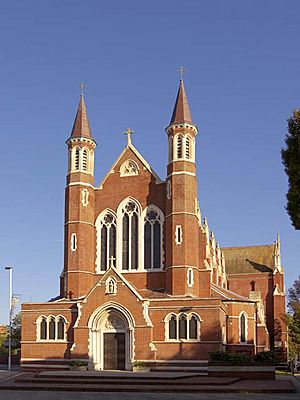
Portsmouth has two cathedrals: the Anglican Cathedral of St Thomas in Old Portsmouth, and the Roman Catholic Cathedral of St John the Evangelist (the city is one of 34 British settlements with a Roman Catholic cathedral). The city's first chapel, dedicated to Thomas Becket, was built by Jean de Gisors in the second half of the 12th century. The chapel was rebuilt and developed into the parish church and then Anglican cathedral. It was damaged during the Siege of Portsmouth in 1642, but after the restoration of the monarchy the tower and nave were rebuilt. Significant changes were made when the Diocese of Portsmouth was established in 1927. It became a cathedral in 1932, and was enlarged, although construction was halted during the Second World War. The cathedral was re-consecrated in the presence of Queen Elizabeth The Queen Mother in 1991.
The Royal Garrison Church was founded in 1212 by Peter des Roches, Bishop of Winchester. After centuries of decay, it became an ammunition store in 1540. The marriage of Charles II to Catherine of Braganza took place in the church in 1662. After the defeat of Napoleon at the Battle of Leipzig in 1914, large receptions were held inside the church. In 1941, a firebomb fell on the roof, destroying the nave. The church's chancel was saved by servicemen shortly after the raid; however, replacing the roof was determined to be impossible due to the large amounts of salt solution the stonework had absorbed over the years.
The Cathedral of St John the Evangelist was built in 1882 to accommodate Portsmouth's increasing Roman Catholic population, replacing a chapel built in 1796 to the west. Before 1791 Roman Catholic chapels in towns with borough status were prohibited. The chapel was opened after the Roman Catholic Relief Act 1791 was passed and then replaced by the cathedral. Its construction was completed in phases: in 1882 the nave was complete; in 1886 the crossing was finished, and the chancel was ready by 1893, eleven years after its opening. During the blitz, the cathedral was badly damaged when Luftwaffe bombing destroyed Bishop's House next door. It was restored in 1970, 1982, and 2001. The Roman Catholic Diocese of Portsmouth was founded in 1882 by Pope Leo XIII.
Smaller places of worship in the city include St Jude's Church in Southsea, St Mary's Church in Portsea, St Ann's Chapel in the naval base, and the Portsmouth and Southsea Synagogue, which is among the oldest synagogues in Britain.
Sport
Portsmouth F.C. play their home games at Fratton Park. They have won two Football League titles (1949 and 1950), and won the FA Cup in 1939 and 2008. The club returned to the Premier League in 2003. They were relegated to the Championship in 2010 and, experiencing serious financial difficulties in February 2012, were relegated again to League One. The club was relegated the following year to League Two, the fourth tier of English football. Portsmouth F.C. was purchased in April 2013 by the Pompey Supporters Trust, becoming the largest fan-owned club in English Football history. In May 2017, as League Two champions, they were promoted to League One for the 2017–18 season. They won promotion back to the Championship as Champions of League One in May 2024.
Moneyfields F.C. have played in the Wessex Football League Premier Division since 1998. United Services Portsmouth F.C. (formerly known as Portsmouth Royal Navy) and Baffins Milton Rovers F.C. compete in Wessex League Division One; United Services was founded in 1962, and Baffins Milton Rovers in 2011. The rugby teams United Services Portsmouth RFC and Royal Navy Rugby Union play their home matches at the United Services Recreation Ground. Royal Navy Rugby Union play in the annual Army Navy Match at Twickenham.
Portsmouth began hosting first-class cricket at the United Services Recreation Ground in 1882, and Hampshire County Cricket Club matches were played there from 1895 to 2000. In 2000, Hampshire moved their home matches to the new Rose Bowl cricket ground in West End. Portsmouth is home to two hockey clubs: Portsmouth Hockey Club, based at the Admiral Lord Nelson School and United Services Portsmouth Hockey Club, based on Burnaby Road. Great Salterns Golf Club, established in 1926, is an 18-hole parkland course with two holes played across a lake; there are coastal courses at Hayling and the Gosport and Stokes Bay Golf Club. Boxing was a popular sport between 1910 and 1960, and a monument commemorating the city's boxing heritage was built in 2017.
Transport
Roads
In March 2008, Portsmouth City Council became the first local authority in the UK to implement city-wide 20 miles per hour speed limit zones.
Ferries
Portsmouth Harbour has passenger-ferry links to Gosport and the Isle of Wight, with car-ferry service to the Isle of Wight nearby. Hovertravel, Britain's longest-standing commercial hovercraft service, begun in the 1960s, runs from near Clarence Pier in Southsea to Ryde, Isle of Wight. Portsmouth International Port has links to Caen, Cherbourg-Octeville, St Malo and Le Havre in France, Santander and Bilbao in Spain, and the Channel Islands. Ferry services from the port are operated by Brittany Ferries and Condor Ferries.
On 18 May 2006, Trasmediterranea began service to Bilbao in competition with P&O's service. Its ferry, Fortuny, was detained in Portsmouth by the Maritime and Coastguard Agency for a number of safety violations. They were quickly corrected and the service was cleared for passengers on 23 May that year. Trasmediterránea discontinued its Bilbao service in March 2007, citing a need to deploy the Fortuny elsewhere. P&O Ferries ended their service to Bilbao on 27 September 2010 due to "unsustainable losses". The second-busiest ferry port in the UK (after Dover), Portsmouth handles about three million passengers per year.
Buses
Local bus services are provided by Stagecoach South and First Hampshire & Dorset to the city and its surrounding towns. Hovertravel and First Hampshire & Dorset operate a Hoverbus service from the city centre to Southsea Hovercraft Terminal and the Hard Interchange, near the seafront. National Express service from Portsmouth operates primarily from the Hard Interchange to Victoria Coach Station, Cornwall, Bradford, Birkenhead and Bristol.
Railways
Portsmouth has four railway stations on Portsea Island: Hilsea, Fratton, Portsmouth & Southsea and Portsmouth Harbour, with a fifth station at Cosham in the northern mainland suburb of Cosham, Portsmouth. Portsmouth previously had additional stations at Southsea, Farlington and Paulsgrove, but these were closed at various periods of the twentieth century.
The city of Portsmouth is on two direct South Western Railway routes to London Waterloo, via Guildford and via Basingstoke. There is a South Western Railway stopping service to Southampton Central and Great Western Railway service to Cardiff Central via Southampton, Salisbury, Bath Spa and Bristol. Southern has service to Brighton, Gatwick Airport, Croydon and London Victoria.
Closed stations
Southsea once had its own branch line, the Southsea Railway, which opened in 1885 between Southsea railway station and Fratton; it was closed in 1914 due to competition from tram services.
Farlington Halt railway station was built to serve Portsmouth Park racecourse, opening as Farlington Race Course on 26 June 1891. The racecourse was closed during World War One, but the station was retained to serve the ammunition dump put in its place. The station closed in 1917. Re-opened in 1922 until 1927. Under the Southern Railway, it re-opened as a general public halt in 1928 named Farlington Halt; however, this was short-lived as the station closed due to insufficient customers on 4 July 1937.
Paulsgrove Halt railway station was a railway station opened in 1928 to serve the adjacent Portsmouth Racecourse, a pony racing stronghold. The station was formerly located between Cosham and Portchester stations. Paulsgrove Halt was closed along with the racecourse when the land was acquired by the military in 1939, at the outbreak of World War II.
Air
Portsmouth Airport, with a grass runway, was in operation from 1932 to 1973. After it closed, housing (Anchorage Park) and industry were built on the site. The nearest airport is Southampton Airport in the Borough of Eastleigh, 19.8 miles (31.9 km) away. It has a South Western Railway rail connection, requiring a change at Southampton Central or Eastleigh. Heathrow and Gatwick are 65 miles (105 km) and 75 miles (121 km) away, respectively. Gatwick is linked by Southern train service to London Victoria station and Heathrow is linked by coach to Woking, which is on both rail lines to London Waterloo and the London Underground. Heathrow is linked to Portsmouth by National Express coaches.
Former canal
The Portsmouth and Arundel Canal ran between the towns and was built in 1823 by the Portsmouth & Arundel Navigation Company. Never financially successful, and found to be contaminating Portsea Island fresh water wells, it was abandoned in 1855 and the company was wound up in 1888. The canal was part of a larger scheme for a secure inland canal route from London to Portsmouth, allowing boats to avoid the English Channel. It had three sections: a pair of ship canals (one on Portsea Island and one to Chichester) and a barge canal from Ford on the River Arun to Hunston, where it joined the canal's Chichester section.
The route through Portsea Island began from a basin formerly located on Arundel Street and cut through Landport, Fratton and Milton, ending at the eastern end of Locksway Road in Milton (where a set of lock gates accessed Langstone and Chichester Harbours. After the island route was closed, the drained canal-bed sections through Landport and Fratton were reused for the Portsmouth Direct line, or filled-in to surface level to form a new main road route to Milton, named Goldsmith Avenue.
The brick-lined canal walls are clearly visible between the Fratton and Portsmouth & Southsea railway stations. The canal lock entrance at Locksway Road in Milton is east of the Thatched House pub.
Future plans
A new public transport structure was once under discussion, including monorails and light rail. Although a light-rail link to Gosport was authorised in 2002 (with completion expected to be in 2005), the project was in jeopardy as the Department for Transport refused to fund it in November 2005. In April 2011, The News reported a scheme to replace conventional rail lines to Southampton via Fareham, Bursledon and Sholing with light rail.
Media
Portsmouth, Southampton and their adjacent towns are served primarily by programming from the Rowridge and Chillerton Down transmitters on the Isle of Wight, although the transmitter at Midhurst can substitute for Rowridge. Portsmouth was one of the first cities in the UK to have a local TV station (MyTV), although the Isle of Wight began local television broadcasting in 1998. In November 2014, That's Solent was introduced as part of a nationwide roll-out of local Freeview channels in south-central England. The stations broadcast from Rowridge.
BBC local radio station that broadcast to the city is BBC Radio Solent on 96.1 FM. According to RAJAR, popular radio stations include regional Greatest Hits Radio South and Global Radio's Heart South and Capital South. Easy Radio South Coast broadcasts from Southampton to the city on 107.4 MHz, and the non-profit community station, Express FM, broadcasts on 93.7. Patients at Queen Alexandra Hospital (Portsmouth's primary hospital) receive local programming from Portsmouth Hospital Broadcasting, which began in 1951. When the first local commercial radio stations were licensed during the 1970s by the Independent Broadcasting Authority (IBA), Radio Victory received the first licence and began broadcasting in 1975. In 1986, the IBA increased the Portsmouth licence to include Southampton and the Isle of Wight. The new licence went to Ocean Sound (later known as Ocean FM), with studios in Fareham; Ocean FM became Heart Hampshire. For the city's 800th birthday in 1994, Victory FM broadcast for three 28-day periods over 18 months. It was purchased by TLRC, who relaunched the station in 2001 as the Quay; Portsmouth Football Club became a stakeholder in 2007, selling it in 2009.
Portsmouth's daily newspaper is The News, founded in 1873 and previously known as the Portsmouth Evening News. The Journal, a free weekly newspaper, is published by News publisher Johnston Press.
Notable residents
Portsmouth has been home to a number of famed authors; Charles Dickens, whose works include A Christmas Carol, Great Expectations, Oliver Twist and A Tale of Two Cities, was born there. Arthur Conan Doyle, author of the Sherlock Holmes stories, practised medicine in the city and played in goal for the amateur Portsmouth Association Football Club. Rudyard Kipling (poet and author of The Jungle Book) and H. G. Wells, author of The War of the Worlds and The Time Machine, lived in Portsmouth during the 1880s. Novelist and historian Walter Besant, author of By Celia's Arbour, A Tale of Portsmouth Town, was born in Portsmouth. Historian Frances Yates, known for her work on Renaissance esotericism, was born in the city. Francis Austen, brother of Jane Austen, briefly lived in the area after graduating from Portsmouth Naval Academy. Contemporary literary figures include social critic, journalist and author Christopher Hitchens, who was born in Portsmouth. Nevil Shute moved to the city in 1934 when he relocated his aircraft company, and his former home is in Southsea. Fantasy author Neil Gaiman grew up in Purbrook and Southsea.
Industrial Revolution engineer Isambard Kingdom Brunel was born in Portsmouth. His father, Marc Isambard Brunel, worked for the Royal Navy and developed the world's first production line to mass-produce pulley blocks for ship rigging. James Callaghan, British prime minister from 1976 to 1979, was born and raised in Portsmouth. Son of a Protestant Northern Irish petty officer in the Royal Navy, Callaghan was the only person to hold all four Great Offices of State: foreign secretary, home secretary, chancellor and prime minister. John Pounds, the founder of ragged schools (which provided free education to working-class children), lived in Portsmouth and founded England's first ragged school there.
Comedian and actor Peter Sellers was born in Southsea, and Arnold Schwarzenegger briefly lived and trained in Portsmouth. Other actors who were born or lived in the city include EastEnders actresses Emma Barton and Lorraine Stanley, comedienne and singer Audrey Jeans, and Bollywood actress Geeta Basra. Cryptozoologist Jonathan Downes was born in Portsmouth, and lived there for a time. Ant Middleton, former SBS, current television presenter and author was born in Portsmouth. Helen Duncan, the last person to be imprisoned under the 1735 Witchcraft Act, was arrested in Portsmouth.
Notable sportspeople include Commonwealth Games gold medalist Michael East, Olympic medallist in cycling Rob Hayles, former British light-heavyweight boxing champion Tony Oakey, Olympic medallist Alan Pascoe as well as professional footballer Mason Mount. Single-handed yachtsman Alec Rose, 2003 World Aquatics Championships gold medallist Katy Sexton, and Olympic medallist Roger Black were also born in the city. Jamshid bin Abdullah of Zanzibar, the last constitutional monarch of the island state, lives in exile in Portsmouth with his wife and six children.
International relations
Twin towns - sister cities
Sources:
- Caen, Normandy, France
- Duisburg, North Rhine-Westphalia, Germany
- Haifa, Haifa District, Israel
- Halifax, Nova Scotia, Canada
- Lakewood, Jefferson County, Colorado, United States
- Maizuru, Kyoto Prefecture, Japan
- Portsmouth, Virginia, United States
- Portsmouth, Rockingham County, New Hampshire, United States
- Sydney, New South Wales, Australia
- Sylhet, Bangladesh
- Zhanjiang, Guangdong, China
Freedom of the City
According to the Portsmouth City Council website, the following individuals and military units have received the Freedom of the City in Portsmouth:
Individuals
- Baron Macnaghten (1895)
- Field Marshal Lord Roberts of Kandahar (1898)
- Sir John Baker (1901)
- Lieutenant General Sir Frederick Fitzwygram (1901)
- Sir William Pink (1905)
- Sir T. Scott Foster (1906)
- Duke of Connaught and Strathearn (1921)
- F. G. Foster (1924)
- David Lloyd George (1924)
- Prince of Wales (1926)
- Major General J. E. B. Seely (1927)
- Sir William Joynson-Hicks (1927)
- Frank J. Privett (1928)
- Sir Harold R. Pink (1928)
- Admiral Sir William James (1942)
- Field Marshal Lord Montgomery of Alamein (1946)
- Sir Winston Churchill (1950)
- Albert Johnson (1966)
- J. P. D. Lacey (1966)
- Sir Alec Rose (1968)
- Admiral of the Fleet Lord Mountbatten of Burma (1976)
- Prince of Wales (1979)
- Lord Callaghan of Cardiff (1991)
- Princess of Wales (1992)
- Lord Judd of Portsea (1995)
- Lady Margaret Daley (1996)
- Josef Krings (1997)
- Ian G. Gibson (2002)
- Milan Mandarić (2003)
- Sir Alfred Blake (2003)
- Brian Kidd (2003), former Head of Parks and Gardens in Portsmouth
- Harry Redknapp (2008)
- Syd Rapson (2016)
Military units
- Royal Hampshire Regiment (1950)
- Royal Marines (1959)
- Portsmouth Command of the Royal Navy (1965)
- Princess of Wales's Royal Regiment (1992)
- HMS King Alfred, RNR (2003)
- HMS Endurance, RN (2007)
Organisations and groups
- Essential Workers of Portsmouth: 16 March 2021 (service will be held in May 2021).
- Royal Naval Association: 8 December 2021.
- Royal Marines Association (Portsmouth Branch): 8 December 2021.
- Association of Wrens and Women of the Royal Naval Services: 8 December 2021.
- Pompey in the Community: 29 March 2022.
- Life House: 15 December 2022.
- The Southern Co-operative Limited: 10 July 2023.
See also
 In Spanish: Portsmouth para niños
In Spanish: Portsmouth para niños










